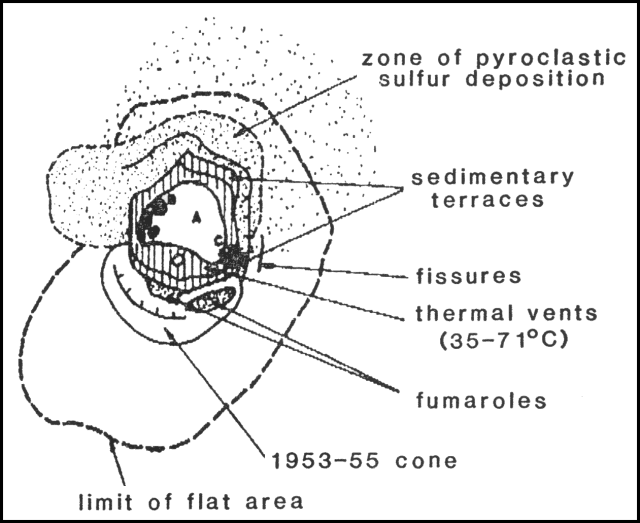Report on Poas (Costa Rica) — January 1989
Scientific Event Alert Network Bulletin, vol. 14, no. 1 (January 1989)
Managing Editor: Lindsay McClelland.
Poas (Costa Rica) H2S emission kills plants; crater lake recedes rapidly
Please cite this report as:
Global Volcanism Program, 1989. Report on Poas (Costa Rica) (McClelland, L., ed.). Scientific Event Alert Network Bulletin, 14:1. Smithsonian Institution. https://doi.org/10.5479/si.GVP.SEAN198901-345040
Poas
Costa Rica
10.2°N, 84.233°W; summit elev. 2697 m
All times are local (unless otherwise noted)
The crater lake has continued to recede and by February 1989 its level was ~12 m lower than on 24 June. During fieldwork on 7 February, the lake was bubbling vigorously and had a temperature of 85°C. Suspended sediment gave it a gray-black color; filtered lake water was yellow-green. Areas of higher heat flow and/or more intense fumarolic activity were indicated by mud plumes >1 m high. Geyser-type eruptions were not observed, and reportedly ended in October. Blocks of altered scoria that approached 3 x 2 x 1.5 m floated on the lake surface, tracing the paths of convection currents (figure 7).
Temperatures of fumaroles on the 1953-55 [dome] decreased from 200-275°C in October 1988 to 64-94°C in February 1989. Fumaroles on lake sediment terraces vented directly into the atmosphere or mixed with water draining from the surrounding crater walls. Hot pools in streams (temperatures 35-71°C) and small mud pots formed and disappeared. The pools were often coated with a layer of precipitated dark green sulfur. Fumaroles on the exposed lake bottom were no hotter than 94°C. They emitted large quantities of H2S, changing the composition of the crater gas plume, which was blown W and SW by strong winds. Reports from SW-flank towns (Grecia, Sarchi, and Naranjo; 17, 18, and 19 km from the crater) indicated that the plume has become more toxic, burning trees and plants closer to the volcano and leaving them dead or dying. Vegetation was damaged in forests, grassland, and some agricultural land, principally in the towns of San Luis and Trojas de Grecia, 11 km SW of the crater. Residents of those towns suffered from eye and throat irritation. Fogs reportedly coated cars and houses with fine sulfur particles, similar to coatings that affected a rain gauge in the crater downwind of the plume. During periods of higher lake level, the H2S had emerged into the lake where it was oxidized to sulfur and H2SO4, so less had reached the atmosphere.
Park personnel reported small explosions during the afternoon of 3 February and at about 0700 on 6 February. The cause of the explosions may have been venting from two small pyroclastic cones composed entirely of sulfur. The larger of the two cones was ~1 m high, and they were separated by a large hole that was the site of vigorous fumarolic activity. Particles of bright yellow pyroclastic sulfur covered ~500 m2 on the NE part of the crater floor.
January 1989 seismicity was the most active of the past 2 years (figure 8). The number of events averaged 307/day at Red Sismológico Nacional station VPS-2, roughly 1 km NW of the lake. The bulk of the events were of low frequency with depths that did not exceed 1 km.
Geological Summary. The broad vegetated edifice of Poás, one of the most active volcanoes of Costa Rica, contains three craters along a N-S line. The frequently visited multi-hued summit crater lakes of the basaltic-to-dacitic volcano are easily accessible by vehicle from the nearby capital city of San José. A N-S-trending fissure cutting the complex stratovolcano extends to the lower N flank, where it has produced the Congo stratovolcano and several lake-filled maars. The southernmost of the two summit crater lakes, Botos, last erupted about 7,500 years ago. The more prominent geothermally heated northern lake, Laguna Caliente, is one of the world's most acidic natural lakes, with a pH of near zero. It has been the site of frequent phreatic and phreatomagmatic eruptions since an eruption was reported in 1828. Eruptions often include geyser-like ejections of crater-lake water.
Information Contacts: Gary Rowe and Susan Brantley, Pennsylvania State Univ, USA; José Francisco Fernández, Chemistry Laboratory, Instituto Costarricense de Electricidad, San José, Costa Rica; Mario Fernández and Luis Diego Morales, Univ de Costa Rica, San José, Costa Rica; R. Barquero and Guillermo Alvarado, ICE; J. Barquero and E. Fernández, OVSICORI.



